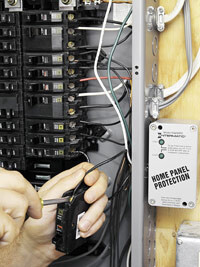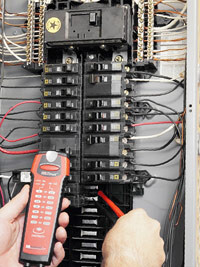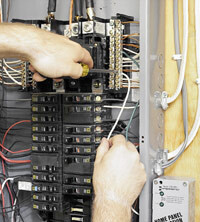Surge protectors protect electronic equipment – computers, DVD players, televisions – from the damaging electrical surges that occur when lightning strikes a power line. They are heavy-duty versions of plug-in protectors that protect your computer. When a surge travels through the line to your house, the surge protector directs it away from your wiring and into the ground – a single protector protects every circuit the box controls. There are three types of protectors. One attaches to the meter and needs to be professionally installed. A second type mounts outside the breaker box. The third type resembles a double breaker and replaces two of the breakers in the breaker box.

Checklist
Time - About 40 minutes
Tools - Voltmeter, slot-head screwdriver
Skills - Adding and removing breakers, taking meter readings, removing knockouts, attaching external box to breaker box
Prep - Obtain a powerful battery-operated light to help you see what you’re doing when the power is off
Materials - Surge arrester, two 20-amp breakers
Step 1
Remove the cover of your breaker box and look for two slots that are on opposite bus bars. Test by taking a meter reading with the power on. If you don’t get a reading in the neighborhood of 240 volts, test other combinations of empty slots until you find two that give you the 240-volt reading.

Step 2
Turn off the power at the main breaker and test to make sure it is off. Remove the knockout on the breaker box that gives you the shortest route to the open slots on the bus bar and attach the surge arrester to the box as directed by the manufacturer. Connect the ground wire to the ground bus and the white wire to the neutral bus. Make sweeping wire curves instead of sharp turns for best performance.

Step 3
Connect the black wires to 20-amp breakers. Snap the breakers into place; remove knockouts for them in the panel cover and replace the cover.
